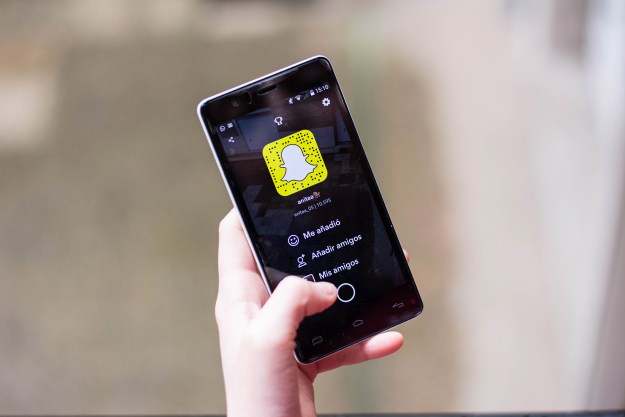
Since Snapchat launched, creators Evan Spiegel and Bobby Murphy have underlined how important it is that the images people share disappear. That’s what makes Snapchat different than other photo-sharing apps, and that’s what they believe the hook is. The assumption is that the allure of impermanence makes every moment you open a snap more valuable because it is fleeting and thus precious.
But the time has come for Snapchat to move beyond its original premise – partially because of new opportunities and trends were seeing from the app’s use… and partially because we can’t be trusted with screen capture capabilities.
The power of screen capture proved too much
Shortly after Snapchat’s launch, users figured out how to capture and store snaps in a variety of ways – and now there’s even a user-friendly app called Snap Save available for iOS. If you want to make a record of a snap you send or receive, it’s very easy. And most users who understand this know that if they really wanted to, the person they’re sharing a picture with could make a copy of what they send. It’s marginally more complicated to store a snap, but far from difficult.
Snaps don’t have the weight of a carefully taken, edited, sent image – they are momentary bits and pieces to be shared casually, immediately.
If you look on other social networks, you’ll see “Snapchat Leaked” communities continue to crop up. These gossipy, mean-spirited pages re-post salacious, sexually explicit snaps, often at the sender’s expense – they basically dump on everything Snapchat wants to be by devaluing conversational privacy and publishing permanent digital records of someone’s intimate, vulnerable snaps. This isn’t the fault of the app itself, but an example of how communities of users can corrupt a service.
And of course, there were also plenty of security experts and hackers who found how to to bring dead snaps back to life. Clearly, workarounds have not been an issue.
So, although Spiegel and Murphy tried to make snaps ephemeral, we resisted the idea of impermanence, creating and relishing in ways to keep these supposedly temporary shots.
Turning the temporary into forever
Not every screenshot and republished snap is malicious, though. Plenty of people repost their innocuous snaps on Tumblr, Facebook, and other social networks — there are 3,413,805 shots on Instagram tagged #snapchat, and most are non-explicit photos from the service people have captured and reposted. It’s a common activity and one that we’re seeing become a popular way to share the private messages of Snapchat with the rest of our social networks.

Yet, as it becomes increasingly apparent that people can and do easily save and publish the photos you send on Snapchat, the app’s business is booming. Onavo Insights found that 1 in 5 U.S. phone users have Snapchat, and the company continues to grow.
An eloquent blog post examining the importance of impermanence in social media recently appeared on the Snapchat blog, written by cultural theorist Nathan Jurgenson. “The Snapchat countdown timer demands an urgency of attention; when you look fast, you look hard. The image might not be perfectly remembered but the story it tells and how you feel in that moment become most salient. Permanent social media fixates on the details of a photo, whereas temporary social media fixates on what it meant and what it moved within you,” Jurgenson writes.
The post lays out a compelling case for temporary social media, but how to reconcile Snapchat’s emphasis on impermanence when its users are constantly coming up with ways to make their snaps more permanent?
Though the “these pictures will self-destruct” element of Snapchat gave it an initial hook, that’s not what is keeping the app popular. Most people understand that if you send a sexy selfie to someone, they can save it. The aura of secrecy has been nullified. So what’s important about Snapchat and why do we still love it if impermanence isn’t so important to use? Why the screenshots, why the Instagrammed snaps?
From impermanence to intimacy
While the fleeting feeling of sending a snap may be gone, the aura of intimacy remains. Sending snaps back and forth feels less like emailing photos and more like using a chat tool. Since the images are rapid-fire and teasing, they encourage replies. They don’t have the weight of a carefully taken, edited, sent image – they are momentary bits and pieces to be shared casually, immediately, and without thought.
If Snapchatting is like instant messaging, then texting is like emailing. Both accomplish the same communication – but one is more off the cuff, and faster, less formal. In both, the content can be revisited, of course.
If Snapchat could keep its images and videos truly temporary, then it would make sense for this focus on impermanence. But that cat is out of the bag and the bag is lying in tatters. And even though ephemerality was heralded as the app’s distinctive feature, its user base continued to grow even after we all learned nothing – not even snaps – were safe.
So what does this mean for Snapchat? First of all, it means that the app shouldn’t worry too much about all of these ways to save photos (although continuing to try and fight Snapchat Leaked communities is a worthwhile effort). And it means that Snapchat can leverage its new-found status as the app that makes chatting and selfies more intimate. It’s more interesting for a friend to screen capture the funny picture you created and sent to her and only her than to make one of yourself and post it on Facebook. It’s saying, “Hey this is a moment we shared that we’re letting you in on! Plus, look at this funny lion’s mane she drew around her face!”
It doesn’t matter if the person you’re sending an image to has the ability to share it, as long as you trust them. People exchanging pictures over Snapchat aren’t doing so because of privacy safeguards; they’re doing so because it’s a fun way to engage in a visually-oriented conversation with friends. The impression of impermanence certainly enhances the “just having a quick chat” feel, but it’s not the essential ingredient – if it were, Snapchat would be dying as more ways to save the images crop up.
Editors' Recommendations
- How to block people on Snapchat
- What do the eyes mean on your Snapchat Story?
- The OG App, an ad-free Instagram client, is no longer on the App Store
- How to half swipe on Snapchat
- A new Snapchat feature lets parents see who their teens chat with


